TOYOTA HIGHLANDER 2016 XU50 / 3.G Quick Reference Guide
Manufacturer: TOYOTA, Model Year: 2016, Model line: HIGHLANDER, Model: TOYOTA HIGHLANDER 2016 XU50 / 3.GPages: 52, PDF Size: 2.28 MB
Page 31 of 52
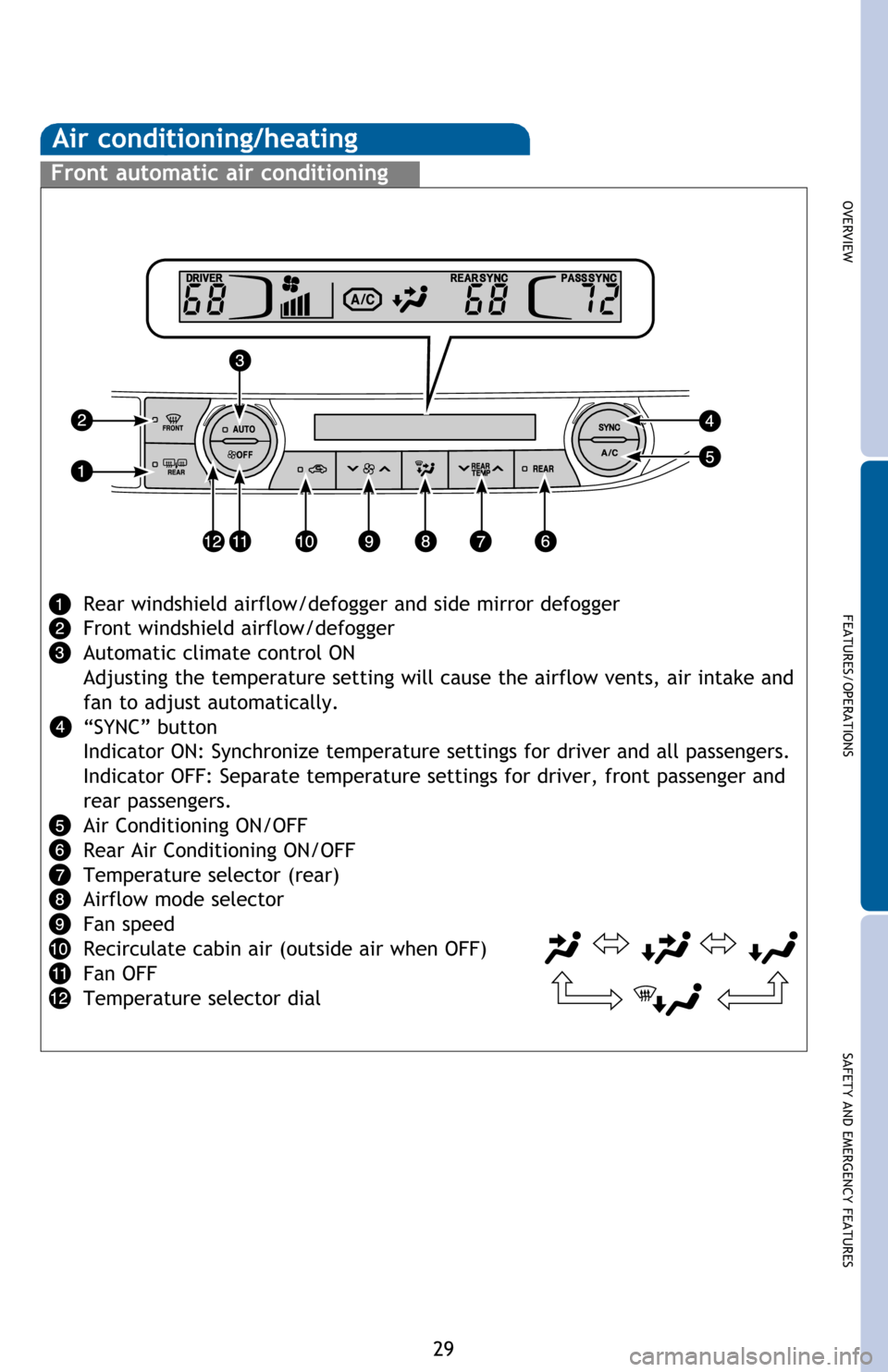
OVERVIEW
FEATURES/OPERATIONS
SAFETY AND EMERGENCY FEATURES
29
Air Conditioning/Heating
Front automatic Air Conditioning
Air conditioning/heating
Front automatic air conditioning
Rear windshield airflow/defogger and side mirror defogger
Front windshield airflow/defogger
Automatic climate control ON
Adjusting the temperature setting will cause the airflow vents, air intake and
fan to adjust automatically.
“SYNC” button
Indicator ON: Synchronize temperature settings for driver and all passengers.
Indicator OFF: Separate temperature settings for driver, front passenger and
rear passengers.
Air Conditioning ON/OFF
Rear Air Conditioning ON/OFF
Temperature selector (rear)
Airflow mode selector
Fan speed
Recirculate cabin air (outside air when OFF)
Fan OFF
Temperature selector dial
Page 32 of 52
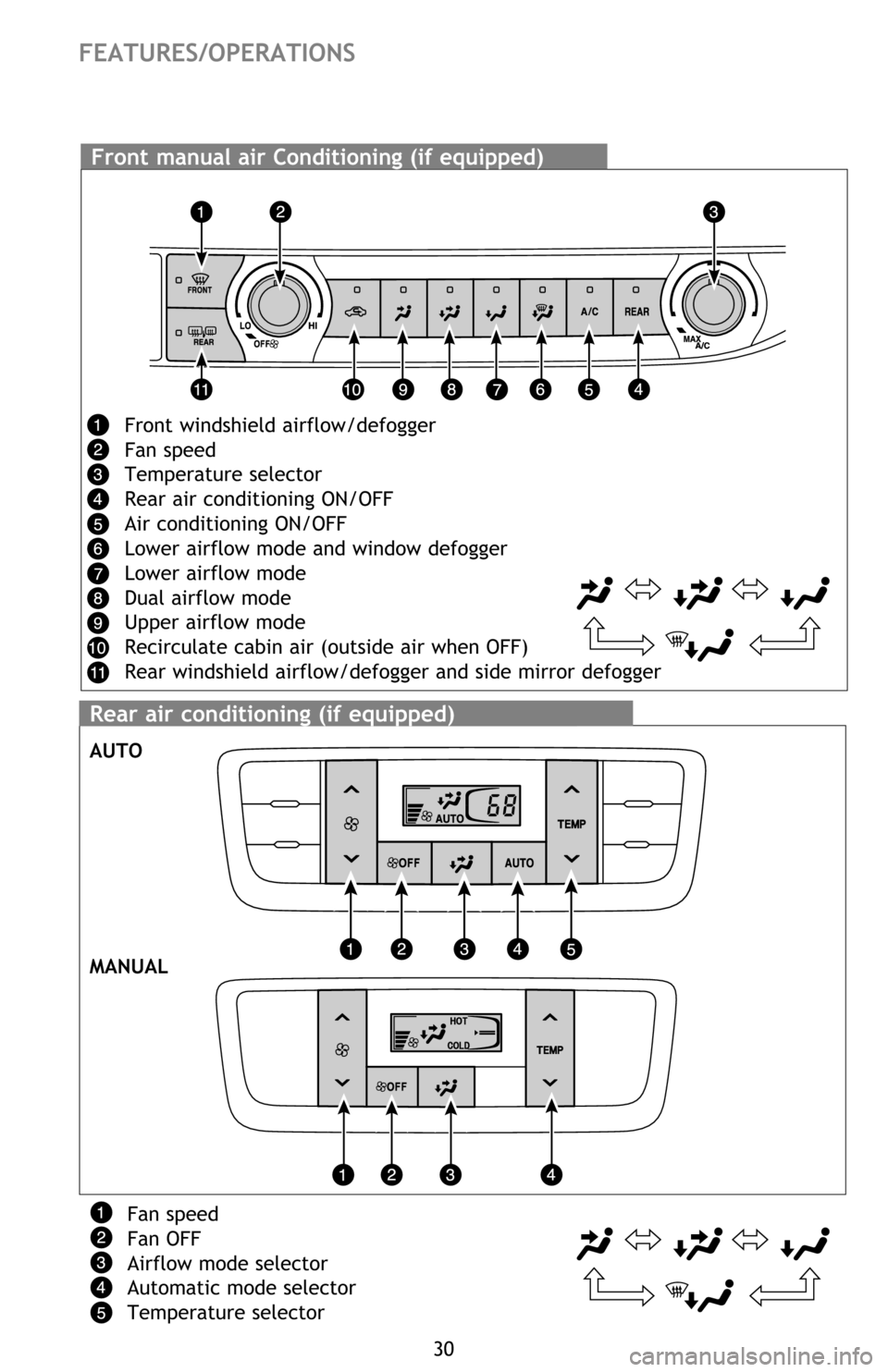
30
FEATURES/OPERATIONS
Front manual Air Conditioning
Front windshield airflow/defogger
Fan speed
Temperature selector
Rear air conditioning ON/OFF
Air conditioning ON/OFF
Lower airflow mode and window defogger
Lower airflow mode
Dual airflow mode
Upper airflow mode
Recirculate cabin air (outside air when OFF)
Rear windshield airflow/defogger and side mirror defogger
Front manual air Conditioning (if equipped)
Rear automatic Air Conditioning (if equipped)
Fan speed
Fan OFF
Airflow mode selector
Automatic mode selector
Temperature selector AUTO
MANUAL
Rear air conditioning (if equipped)
Page 33 of 52
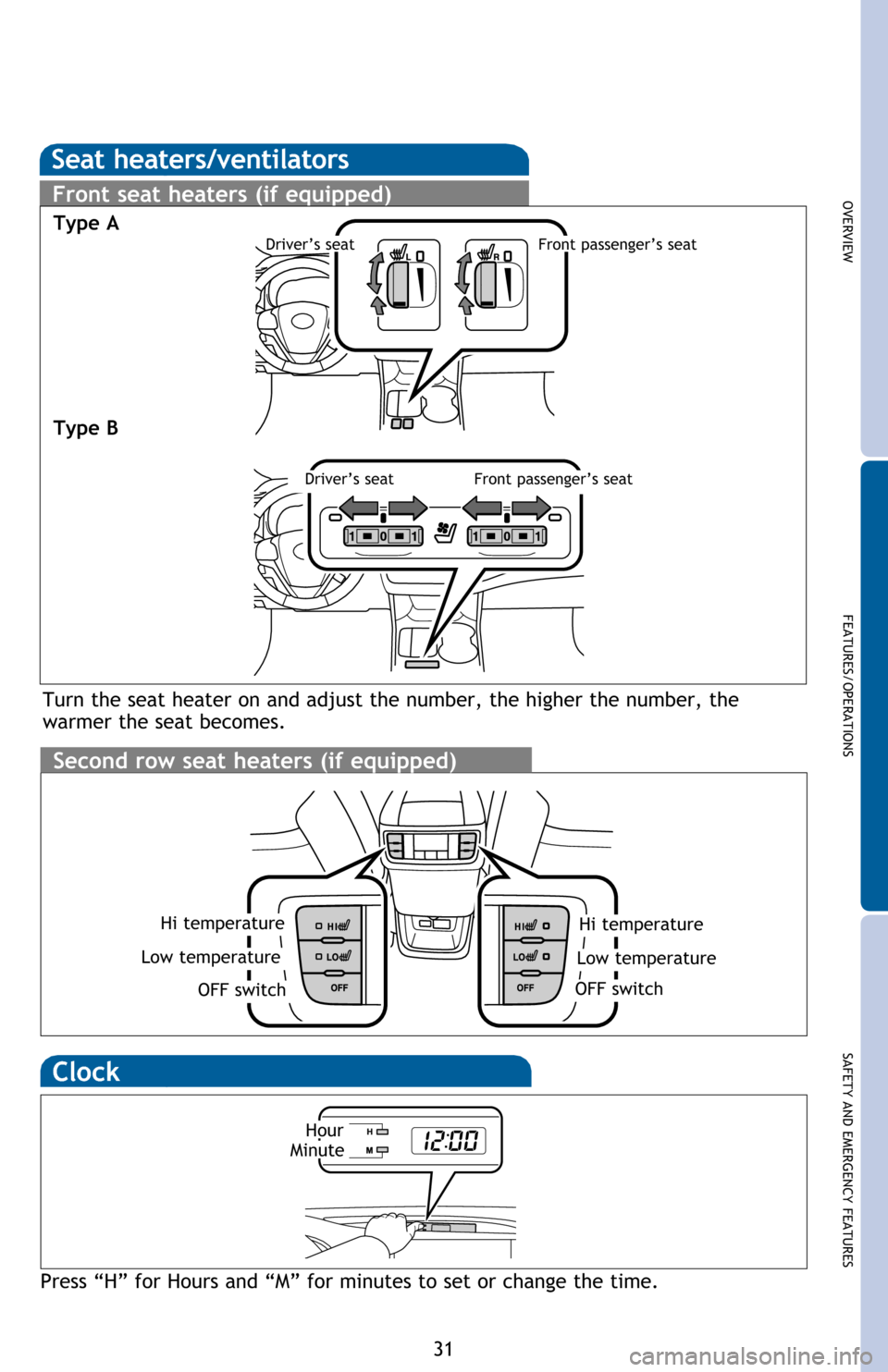
31
OVERVIEW
FEATURES/OPERATIONS
SAFETY AND EMERGENCY FEATURES
Clock
Press “H” for Hours and “M” for minutes to set or change the time.
HourMinute
Hi temperature
OFF switch
Low temperature
Second row seat heaters (if equipped)
Hi temperature
OFF switch
Low temperature
Seat heaters/ventilators
Turn the seat heater on and adjust the number, the higher the number, the
warmer the seat becomes.
Front seat heaters (if equipped)
Driver’s seatFront passenger’s seat
Type B Type A
Driver’s seatFront passenger’s seat
Page 34 of 52
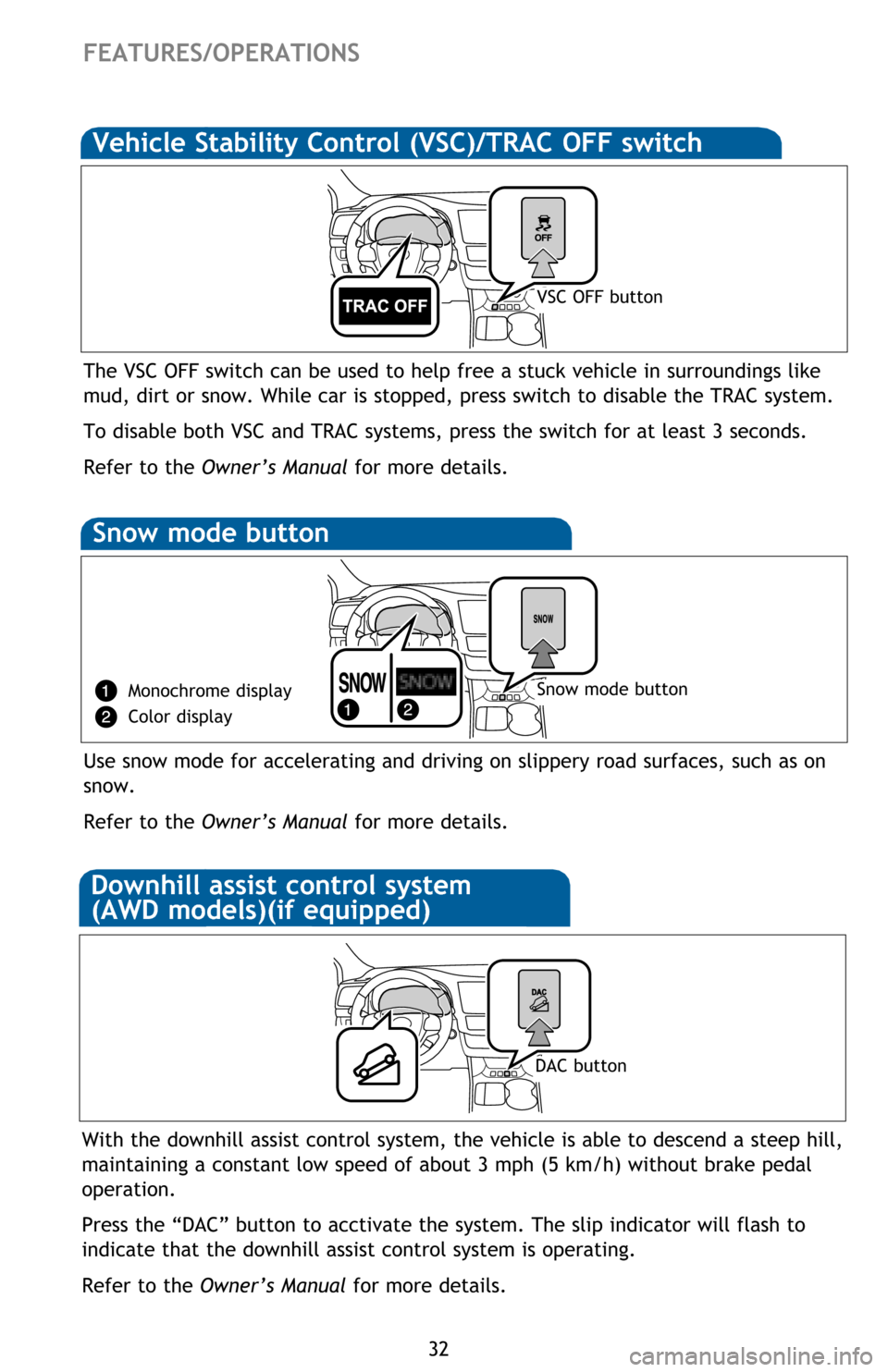
32
FEATURES/OPERATIONS
Downhill assist control system
(AWD models)(if equipped)
With the downhill assist control system, the vehicle is able to descend a steep hill,
maintaining a constant low speed of about 3 mph (5 km/h) without brake pedal
operation.
Press the “DAC” button to acctivate the system. The slip indicator will flash to
indicate that the downhill assist control system is operating.
Refer to the Owner’s Manual for more details.
DAC button
The VSC OFF switch can be used to help free a stuck vehicle in surroundings like
mud, dirt or snow. While car is stopped, press switch to disable the TRAC system.
To disable both VSC and TRAC systems, press the switch for at least 3 seconds.
Refer to the Owner’s Manual for more details.
VSC OFF button
Vehicle Stability Control (VSC)/TRAC OFF switch
Use snow mode for accelerating and driving on slippery road surfaces, such as on
snow.
Refer to the Owner’s Manual for more details.
Snow mode button
Snow mode button
Monochrome display
Color display
Page 35 of 52
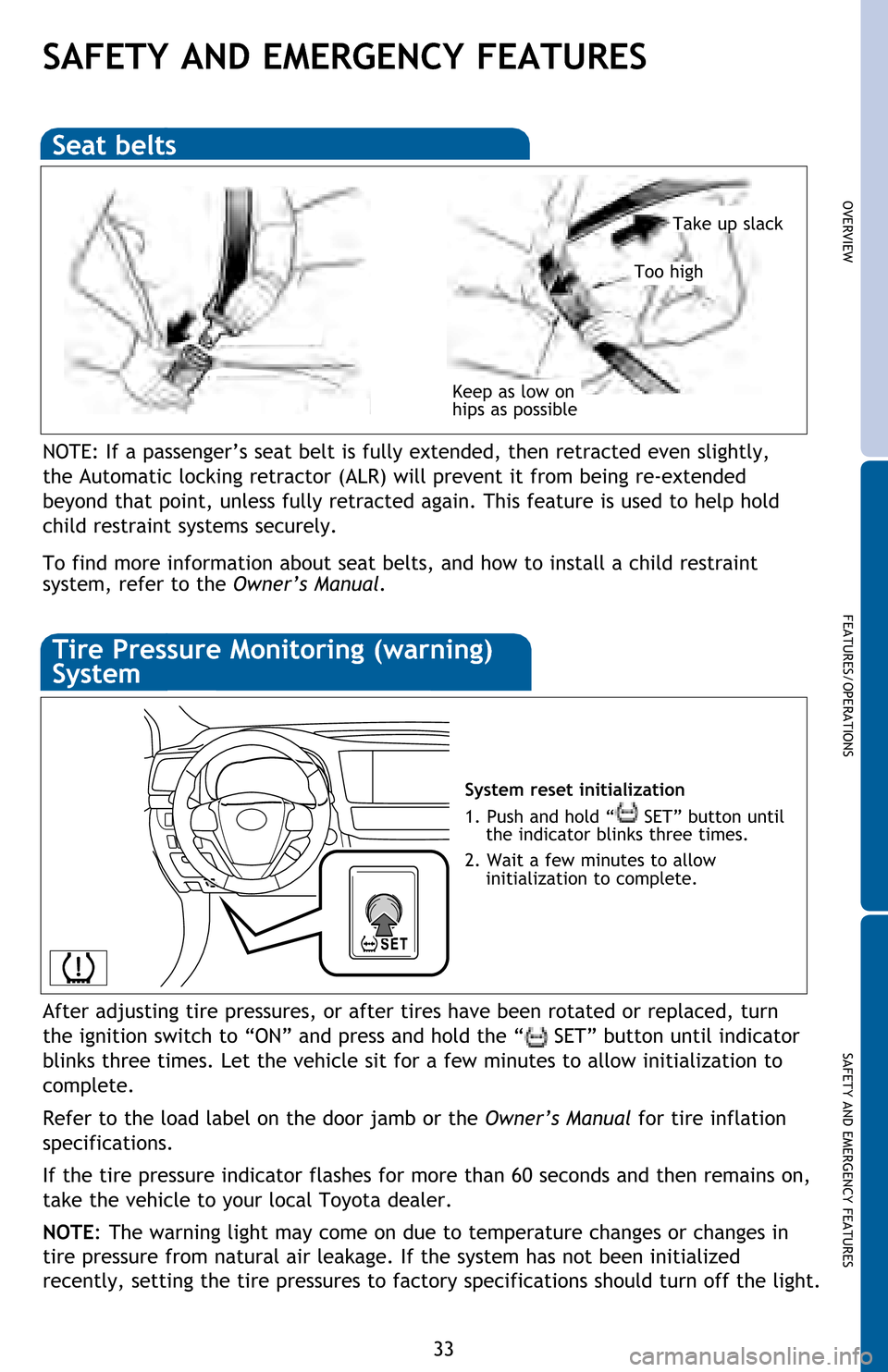
33
OVERVIEW
FEATURES/OPERATIONS
SAFETY AND EMERGENCY FEATURES
SAFETY AND EMERGENCY FEATURES
Keep as low on
hips as possible
Take up slack
Too high
Seat belts
System reset initialization
1. Push and hold “
SET” button until
the indicator blinks three times.
2. Wait a few minutes to allow
initialization to complete.
Tire Pressure Monitoring (warning)
System
After adjusting tire pressures, or after tires have been rotated or replaced, turn
the ignition switch to “ON” and press and hold the “
SET” button until indicator
blinks three times. Let the vehicle sit for a few minutes to allow initialization to
complete.
Refer to the load label on the door jamb or the Owner’s Manual for tire inflation
specifications.
If the tire pressure indicator flashes for more than 60 seconds and then remains on,
take the vehicle to your local Toyota dealer.
NOTE: The warning light may come on due to temperature changes or changes in
tire pressure from natural air leakage. If the system has not been initialized
recently, setting the tire pressures to factory specifications should turn off the light.
NOTE: If a passenger’s seat belt is fully extended, then retracted even slightly,
the Automatic locking retractor (ALR) will prevent it from being re-extended
beyond that point, unless fully retracted again. This feature is used to help hold
child restraint systems securely.
To find more information about seat belts, and how to install a child restraint
system, refer to the Owner’s Manual.
Page 36 of 52
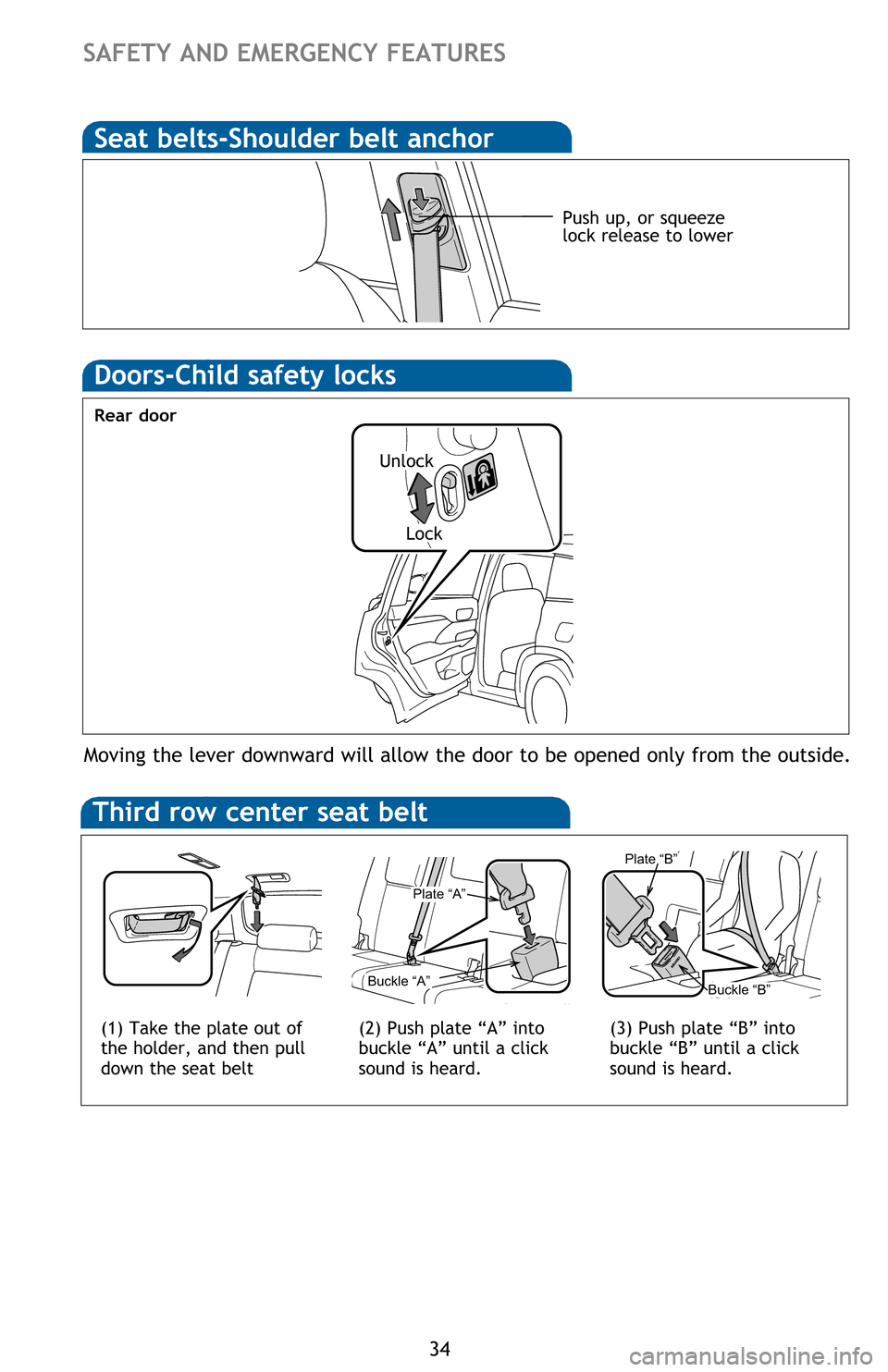
34
Moving the lever downward will allow the door to be opened only from the outside.
Rear door
Doors-Child safety locks
Push up, or squeeze
lock release to lower
Seat belts-Shoulder belt anchor
Unlock
Lock
Third row center seat belt
Plate “A”
Buckle “A”
(1) Take the plate out of
the holder, and then pull
down the seat belt
Plate “B”
Buckle “B”
(2) Push plate “A” into
buckle “A” until a click
sound is heard.(3) Push plate “B” into
buckle “B” until a click
sound is heard.
SAFETY AND EMERGENCY FEATURES
Page 37 of 52
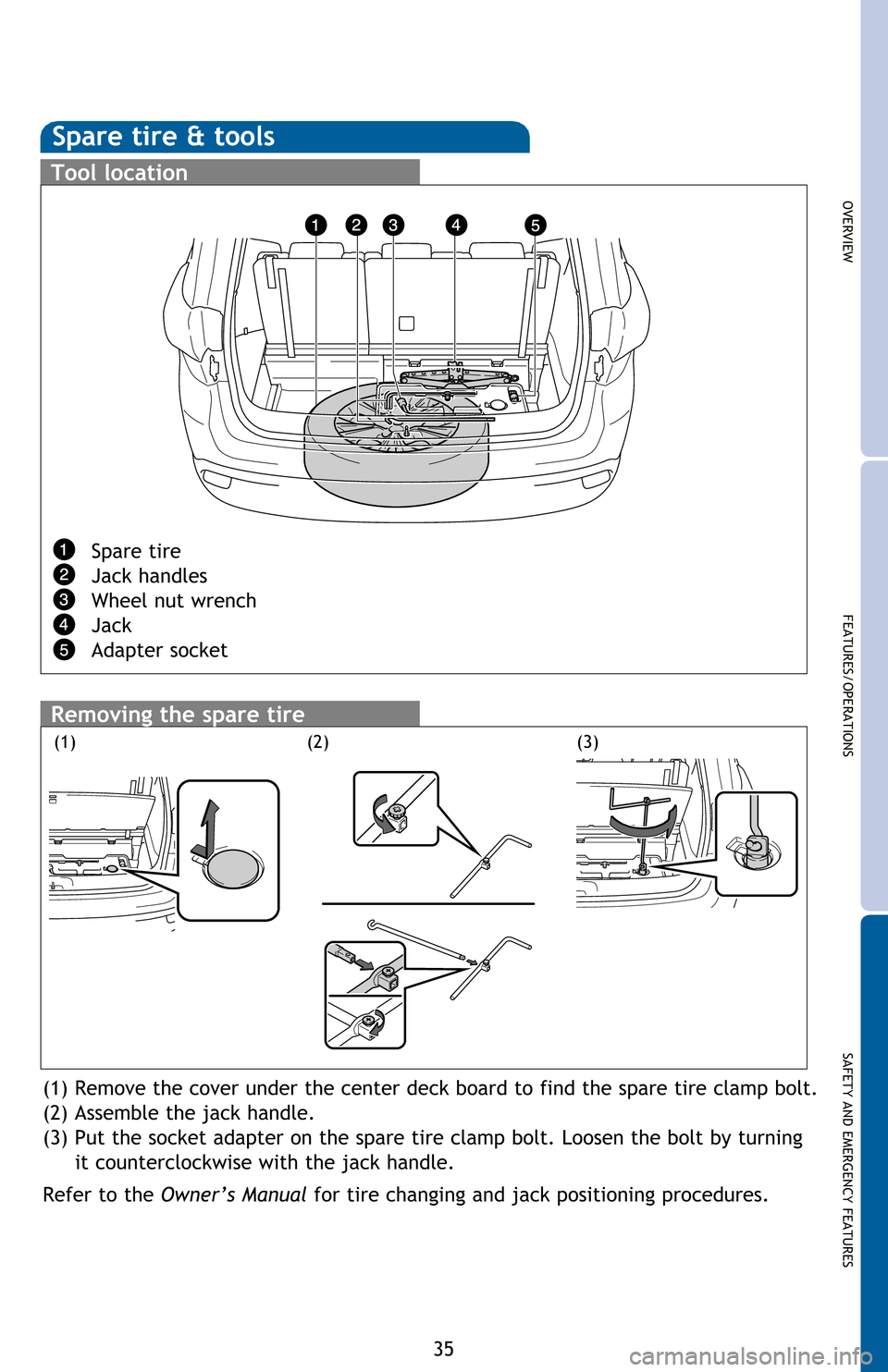
35
OVERVIEW
FEATURES/OPERATIONS
SAFETY AND EMERGENCY FEATURES
Spare tire & tools
Tool location
Removing the spare tire
(1)(3)(2)
Spare tire
Jack handles
Wheel nut wrench
Jack
Adapter socket
(1) Remove the cover under the center deck board to find the spare tire clamp bolt.
(2) Assemble the jack handle.
(3) Put the socket adapter on the spare tire clamp bolt. Loosen the bolt by turning
it counterclockwise with the jack handle.
Refer to the Owner’s Manual for tire changing and jack positioning procedures.
Page 38 of 52
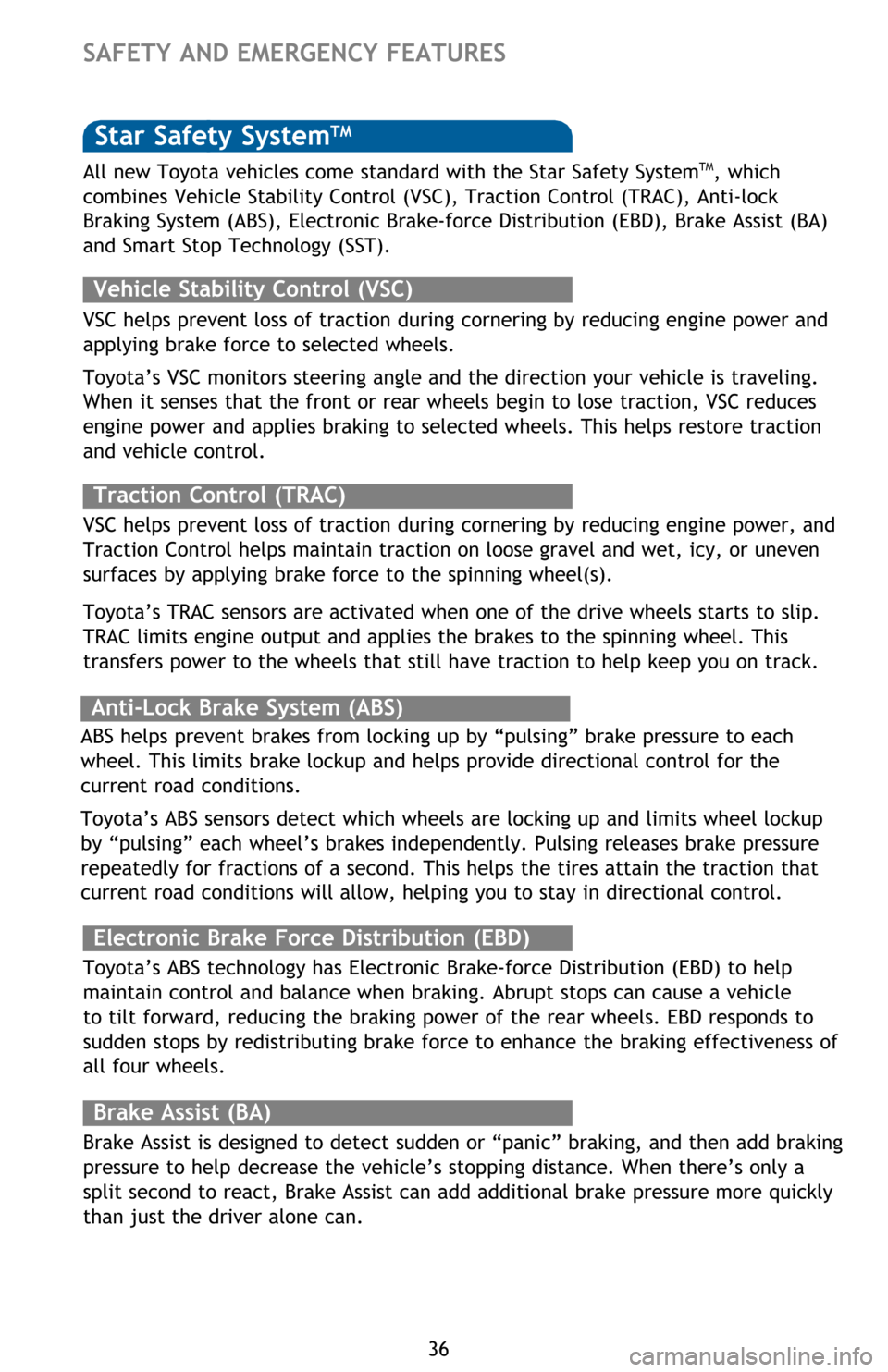
36
Star Safety SystemTM
VSC helps prevent loss of traction during cornering by reducing engine power and
applying brake force to selected wheels.
Toyota’s VSC monitors steering angle and the direction your vehicle is traveling.
When it senses that the front or rear wheels begin to lose traction, VSC reduces
engine power and applies braking to selected wheels. This helps restore traction
and vehicle control.
Vehicle Stability Control (VSC)
Anti-Lock Brake System (ABS)
Brake Assist (BA)
ABS helps prevent brakes from locking up by “pulsing” brake pressure to each
wheel. This limits brake lockup and helps provide directional control for the
current road conditions.
Toyota’s ABS sensors detect which wheels are locking up and limits wheel lockup
by “pulsing” each wheel’s brakes independently. Pulsing releases brake pressure
repeatedly for fractions of a second. This helps the tires attain the traction that
current road conditions will allow, helping you to stay in directional control.
Brake Assist is designed to detect sudden or “panic” braking, and then add braking
pressure to help decrease the vehicle’s stopping distance. When there’s only a
split second to react, Brake Assist can add additional brake pressure more quickly
than just the driver alone can. VSC helps prevent loss of traction during cornering by reducing engine power, and
Traction Control helps maintain traction on loose gravel and wet, icy, or uneven
surfaces by applying brake force to the spinning wheel(s).
Toyota’s TRAC sensors are activated when one of the drive wheels starts to slip.
TRAC limits engine output and applies the brakes to the spinning wheel. This
transfers power to the wheels that still have traction to help keep you on track.
Traction Control (TRAC)
Electronic Brake Force Distribution (EBD)
Toyota’s ABS technology has Electronic Brake-force Distribution (EBD) to help
maintain control and balance when braking. Abrupt stops can cause a vehicle
to tilt forward, reducing the braking power of the rear wheels. EBD responds to
sudden stops by redistributing brake force to enhance the braking effectiveness of
all four wheels. All new Toyota vehicles come standard with the Star Safety System
TM, which
combines Vehicle Stability Control (VSC), Traction Control (TRAC), Anti-lock
Braking System (ABS), Electronic Brake-force Distribution (EBD), Brake Assist (BA)
and Smart Stop Technology (SST).
SAFETY AND EMERGENCY FEATURES
Page 39 of 52
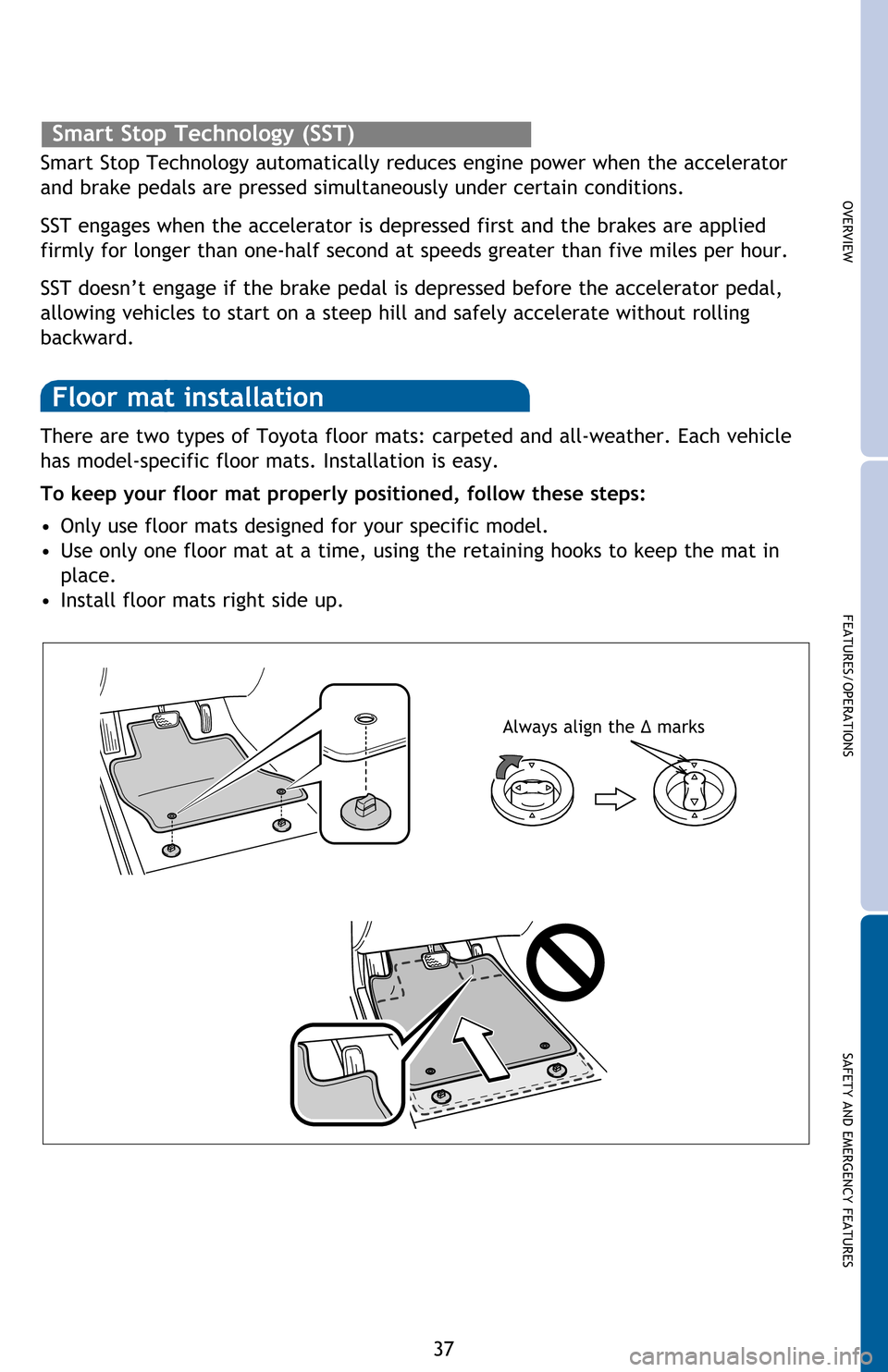
37
OVERVIEW
FEATURES/OPERATIONS
SAFETY AND EMERGENCY FEATURES
There are two types of Toyota floor mats: carpeted and all-weather. Each vehicle
has model-specific floor mats. Installation is easy.
To keep your floor mat properly positioned, follow these steps:
• Only use floor mats designed for your specific model.
• Use only one floor mat at a time, using the retaining hooks to keep the mat in
place.
• Install floor mats right side up.
Floor mat installation
Smart Stop Technology automatically reduces engine power when the accelerator
and brake pedals are pressed simultaneously under certain conditions.
SST engages when the accelerator is depressed first and the brakes are applied
firmly for longer than one-half second at speeds greater than five miles per hour.
SST doesn’t engage if the brake pedal is depressed before the accelerator pedal,
allowing vehicles to start on a steep hill and safely accelerate without rolling
backward.
Smart Stop Technology (SST)
Always align the �¨ marks
Page 40 of 52
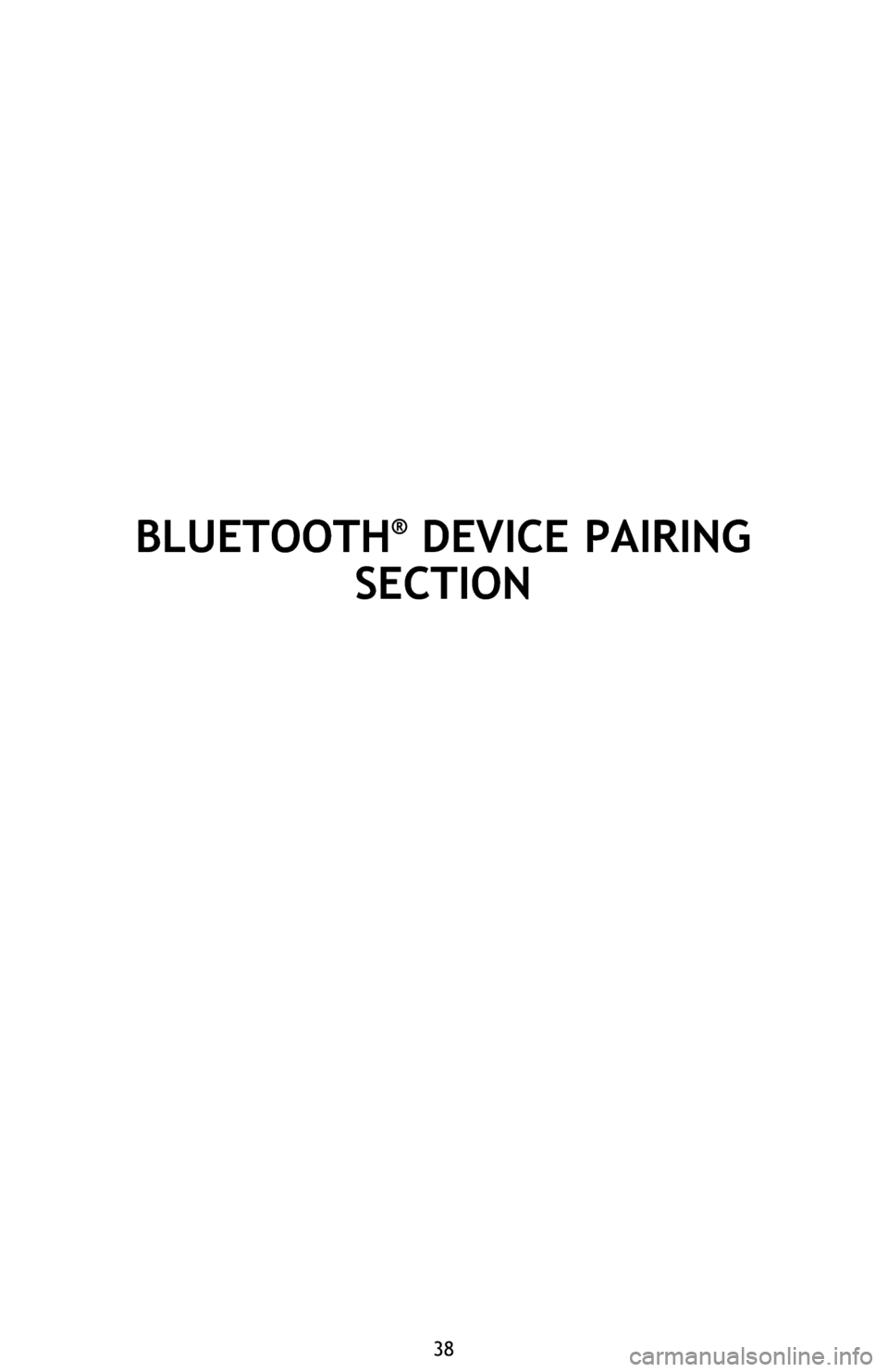
38
BLUETOOTH® DEVICE PAIRING
SECTION